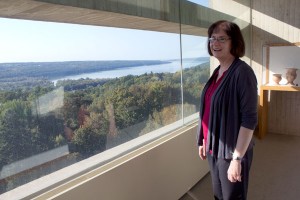Caution tape, the buzz of machinery and dust in the air disguise the distinct contours and stark angles of the Herbert F. Johnson Museum of Art’s newest installation — a just-finished 16,000-square-foot wing.

The Johnson Museum at Cornell University opened its newest expansion to the public Oct. 15, which will be followed later this year with a renovation of the original building.
The new wing contains a window-filled lobby, new storage space, a flexible lecture hall and galleries, including one especially for contemporary art. A Japanese garden sits right outside the lobby designed by Marc Peter Keane, a Cornell ’79 graduate. In the garden, a design of rocks runs along the wall, coming out of a basin of water and creating the illusion of running water.
Nancy Green, curator of prints, drawings and photographs, said she appreciates the style of the addition.
“Just the fact that it brings light into areas where there hasn’t been light before, it’s beautiful,” she said.
Pei Cobb Freed & Partners Architects designed the museum’s main structure. Pei’s original design called for an underground northern wing that would break through the gorges. But, it was never completed due to a lack of funding after the stock market crash in 1973.
“An important thing about the new wing is that it’s based on an original design that I. M. Pei had made,” Green said. “It’s not exactly what he originally designed but his firm is still very much involved, and they’re the ones who did the new wing. It makes it a very seamless marriage and looks like an extension.”
The construction went well, besides the discovery of mercury underground that had to be removed. The museum did not close, and the parking situation remained the same, according to Andrew Weislogel, master teacher and associate curator at the museum.
“That’s not without its toll on the staff,” he said. “It’s stressful to go through a renovation and still be working and trying to do everything you’re trying to do when someone is putting up wallboard, but we’ve come through it with flying colors.”
Peter Gould, deputy director of the museum, said while the renovation was time-consuming, it was worth the efforts.
“It’s taken longer than we thought, but it’s turned out really well,” he said. “A lot of museums when they expand, they
overreach. It meets our needs, but at the same time, we were able to afford it so we still have the resources to take advantage of it.”
The museum had only 9,000 works when it first opened, but now owns more than 35,000 pieces, ranging from Ancient Egyptian ceramics to art created this year, with a specialization in Asian art. Twenty-two million dollars from grants and private gifts enabled the expansion and upcoming renovation.
The renovation will complement two already completed projects in the original building. The fifth floor Asian galleries re-opened in April, completely gutted and redone. A new visible storage space replaced the old lecture room with pieces from every era in the collection. IPod Touches available to visitors help them navigate the artwork on display in accessible storage in drawers below, similar to the computer station on the fifth floor with programs and games related to the Asian collections. Further renovations will include the addition of a photography lab later this year.
Chief Curator Ellen Avril said these projects, especially the new space, will help the museum now and in the future.
“It’s improving our programming spacing and how we can display collections in galleries,” Avril said.
Gould said the work will greatly expand the visitor experience, allow more in-museum teaching, and most importantly, help showcase the art.
“We have spaces that are better suited to contemporary art,” he said. “Artists today are doing things with video, suspending things from the ceiling.”
The addition will not only allow more pieces to be on display, but also showcase a major and often overlooked work of art at the Johnson — the architecture.
“Seeing the new wing open is fantastic because it’s something that’s been in the mental works for such a long time,” Green said. “It’s changed the way all of us see the museum.”




